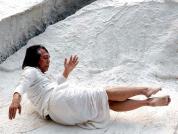
Sardono Kusumo and the Making of Diponegoro
Sardono Kusumo, who is known by his first name Sardono, is one of Indonesia’s most prominent dancers and choreographers. Born in Solo, in the southern part of Indonesia’s island of Java, Sardono studied classical Javanese dance in his youth. A major performer and choreographer, Sardono is also well known for his social activism and as a leader of the Indonesian arts community.
Sardono stands at the intersection of contemporary and traditional dance, reinterpreting classical Javanese techniques together with modern forms.
Sardono made his overseas debut as a young dancer representing Indonesia at the World's Fair in New York City in 1964. Upon return to Indonesia, he took the stage in the first performances of the Ramayana, held at Prambanan is the largest Hindu temple compound in Central Java. He went on to create seminal works with different ethnic groups in Indonesia, while also working to support environmental causes across the archipelago.
In his work, Diponegoro, Sardono brings to life the story of a man who lived, as Diponegoro scholar Peter Carey has termed it, “at a critical phase in the history of the world, a turning point for the future of Indonesia.” Diponegoro, who was born of Java’s royal lineage, spent his first seven years in the royal kraton or court of Jogyakarta, but was also well exposed to the life of the common worker and the farmer. It was frequently foretold that Diponegoro would play a leading, if ultimately failed, role in the attempt to overthrow the Dutch. Indeed, Diponegoro was a leader in the Java War of 1825-1830. In 1830 at the time of his defeat, Diponegoro negotiated a truce but was soon exiled to Makassar.
The rebel leader is regarded as an Indonesian national hero. His story has been famously captured by one of Indonesia’s most renowned painters, Raden Saleh, a contemporary of Diponegoro’s. His painting, The Arrest of Prince Diponegoro (1857) depicts the betrayal and capture of the prince. In it, Saleh is said to have presented the Dutch colonizers as pompous but uneasy, while the Indonesians featured in the painting appear balanced and more natural. Saleh may have placed himself as one of the Javanese figures in the painting.
The Arrest of Prince Diponegoro comprises an important backdrop to Sardono’s dance theatre piece, where the choreographer has reproduced a large scale version as a scrim through which the dancers are seen performing either in front of or behind the image, creating a powerful palimpsest of one of Indonesia’s most enduring scenes.
For a closer look at Prince Diponegoro, see The Javanese Messiah by Peter Carey, an examination of the role of both Diponegoro and Islam in the making of modern Indonesia. Peter Carey, Laithwaite tutor in History at Trinity College, Oxford, has made a lifetime study of Diponegoro and the history of nineteenth-century Java. He is the author of The Power of Prophecy; Prince Dipanagara and the End of an Old Order in Java, 1785-1855(2007).

